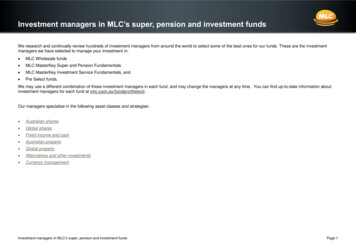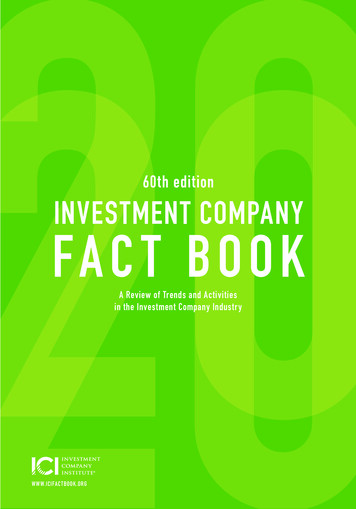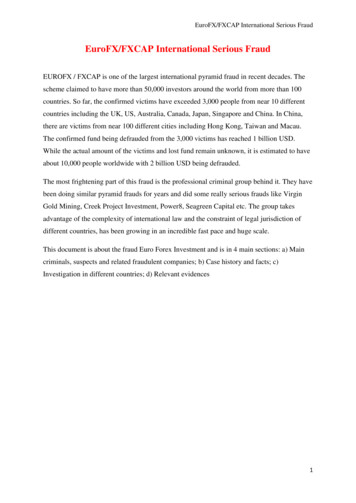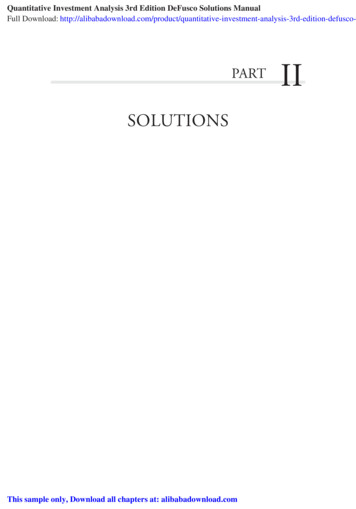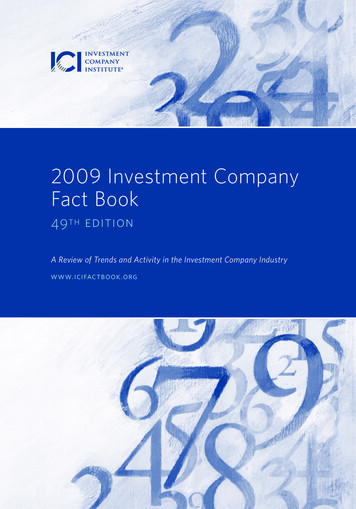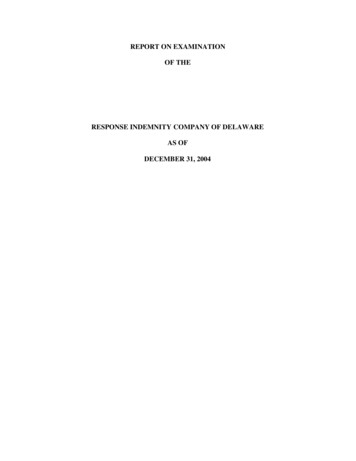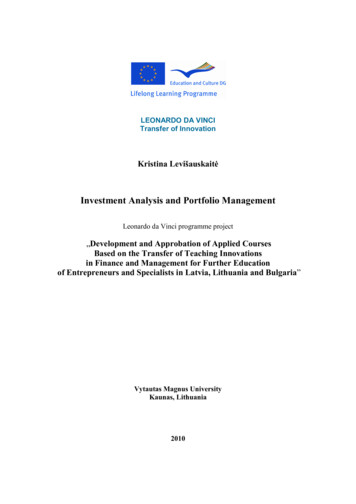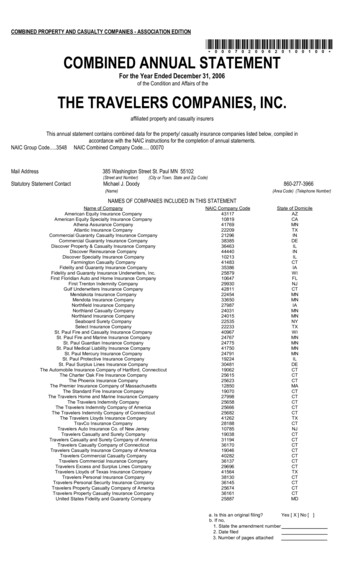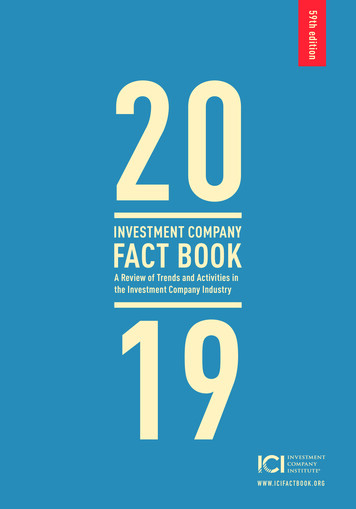
Transcription
59th edition2019INVESTMENT COMPANYFACT BOOKA Review of Trends and Activities inthe Investment Company IndustryW W W. I C I FA C T B O O K . O R G
2018 Facts at a GlanceTotal worldwide assets invested in regulated open-end funds* 46.7 trillionUnited States 21.1 trillionEurope 16.5 trillionAsia-Pacific 6.4 trillionRest of the world 2.7 trillionUS-registered investment company total net assets 21.4 trillionMutual funds 17.7 trillionExchange-traded funds 3.4 trillionClosed-end funds 250 billionUnit investment trusts 70 billionUS-registered investment companies’ share of:US corporate equity30%US and foreign corporate bonds20%US Treasury and government agency securities13%US municipal securities25%Commercial paper24%US household ownership of US-registered fundsNumber of households owning funds57.2 millionNumber of individuals owning funds101.6 millionPercentage of households owning fundsMedian mutual fund assets of mutual fund–owning householdsMedian number of mutual funds owned44.8% 150,0004US retirement marketTotal retirement market assetsPercentage of households with tax-advantaged retirement savingsIRA and DC plan assets invested in mutual funds 27.1 trillion62% 8.2 trillion* Regulated open-end funds include mutual funds, exchange-traded funds (ETFs), and institutional funds.
2019INVESTMENT COMPANYFACT BOOKA Review of Trends and Activities inthe Investment Company Industry
59th edition2019INVESTMENT COMPANYFACT BOOKA Review of Trends and Activities inthe Investment Company IndustryWWW.ICIFACTBOOK.ORG
The Investment Company Institute (ICI) is the leading association representing regulated funds globally, includingmutual funds, exchange-traded funds (ETFs), closed-end funds, and unit investment trusts (UITs) in the UnitedStates, and similar funds offered to investors in jurisdictions worldwide. ICI seeks to encourage adherence to highethical standards, promote public understanding, and otherwise advance the interests of funds, their shareholders,directors, and advisers. ICI carries out its international work through ICI Global, with offices in London, Hong Kong,and Washington, DC.Although information or data provided by independent sources is believed to be reliable, ICI is not responsible for itsaccuracy, completeness, or timeliness. Opinions expressed by independent sources are not necessarily those of theInstitute. If you have questions or comments about this material, please contact the source directly.Fifty-ninth editionISBN 1-878731-66-1Copyright 2019 by the Investment Company Institute. All rights reserved.
CONTENTSviiixLetter from the Chief EconomistICI Research Staff and PublicationsPART ONEAnalysis and Statistics02List of Figures08Chapter OneWorldwide Regulated Open-End Funds30Chapter TwoUS-Registered Investment Companies54Chapter ThreeUS Mutual Funds78Chapter FourUS Exchange-Traded Funds100 Chapter FiveUS Closed-End Funds112 Chapter SixUS Fund Expenses and Fees134 Chapter SevenCharacteristics of US Mutual FundOwners152 Chapter EightUS Retirement and Education SavingsPART TWOData Tables188 List of Data Tables192 Section OneUS Mutual Fund Totals200 Section TwoUS Closed-End Funds, Exchange-TradedFunds, and Unit Investment Trusts206 Section ThreeUS Long-Term Mutual Funds226 Section FourUS Money Market Funds233 Section FiveAdditional Categories of US MutualFunds251 Section SixInstitutional Investors in the US MutualFund Industry254 Section SevenRetirement Account Investing inUS Mutual Funds256 Section EightWorldwide Regulated Open-EndFund Totals262 Appendix AHow US-Registered Investment Companies Operate and the Core Principles UnderlyingTheir Regulation286 Appendix BSignificant Events in Fund History289 Glossary304 Index
LETTER FROMTHE CHIEFECONOMISTLETTER FROM THE CHIEF ECONOMISTvii
LETTER FROM THE CHIEF ECONOMISTGlobalization has hit a few speed bumps in recent years in the form of the global financialcrisis, Brexit, trade tensions, slowing growth, and other developments.But none of this has slowed the globalization of the Investment Company Fact Book.Consistent with ICI’s mission to represent the interests of regulated funds and their investorsworldwide, Fact Book is expanding its international presence.In November 2018, ICI President and CEO Paul Schott Stevenswas present in Beijing as the Asset Management Associationof China rolled out a version of ICI’s 58th annual Fact Bookin Mandarin. This translation will be made available publiclylater this summer.China’s interest in our data is not unique. Across theworld there are increasing demands for the kinds of data,analysis, and institutional detail presented in the Fact Book and other work ICI’s ResearchDepartment produces. These demands reflect a range of concerns—how to structure nascentfund industries to best ensure their growth; what kinds of fund products and design featuresretirement savers may find most helpful and how to assess their preparedness for retirement;how households may respond to tax incentives to save; how regulations in one area mayaffect funds in another area or across the globe; how investors respond to financial marketdevelopments (such as business or interest rate cycles); how funds are reacting to heightenedinvestor interest in environmental, social, and governance (ESG) matters, and, frankly, a thirstfor a long, cool drink of hard facts in what—in some regions—may feel like a data desert.Judy Steenstra, ICI senior director of statistical research, and her group continue to producemore than 300 reports annually on US fund assets, flows, and other characteristics. Wesummarize many of these reports in data tables in Part 2 of this book. On behalf of theInternational Investment Funds Association (IIFA) and its 40 member associations, ICI alsoserves as a repository of global data on fund flows and assets. This past year, under IIFA’sdirection and guidance, we were able to expand the historical data available on the websitesof both IIFA and ICI.viii2019 INVESTMENT COMPANY FACT BOOK
Our work on retirement issues, long a staple interest for thosefocusing on the US market, also has gone global. Peter Brady, ICI senioreconomist, traveled to China this past year for the Mandarin-languagelaunch of his groundbreaking book that challenges the notion of an“upside-down” retirement system that only benefits the wealthy, HowAmerica Supports Retirement: Challenging the Conventional Wisdom onWho Benefits. (A Japanese-language version will be published later thisyear.)Sarah Holden, ICI senior director of retirement and investor research, and her group continueto produce a range of detailed surveys on households’ holdings of funds and sentimentabout funds and fund investing. Household surveys also shed light on retirement savers’motivations and views on choice and control of their retirement accounts. But their analysesand surveys do global duty as well, serving to promote understanding abroad (in venuessuch as the Organisation for Economic Co-operation and Development) about the natureand successes of the US retirement system and to help promote better understanding of theadvantages and disadvantages of retirement systems in other countries.Finally, the Research Department continues to project a global presence on key issues forfinancial markets. We have expanded our global chapter in Fact Book this year to include amore in-depth discussion of investor demand for funds in 2018 and a brief summary of theChinese money market fund industry. Shelly Antoniewicz, ICI senior director of industry andfinancial analysis, in coordination with Jane Heinrichs, ICI associate general counsel, helpedorganize a London-based committee on the global exchange-traded fund (ETF) market.Its inaugural in-person meeting in fall 2018 assembled more than 40 participants in theEuropean ETF ecosystem to explore ETF priorities. James Duvall, ICI associate economist,undertook significant work on trends in costs and charges on Undertakings for CollectiveInvestments in Transferable Securities (UCITS). Other ICI economists made a range of visitsto regulators, media, and academics around the globe to address policymakers’ concernsabout funds and financial stability and about the “common ownership” hypothesis.No matter how the process of globalization plays out, our efforts to improve understandingof funds and their investors—and to promote public policy that advances their interests—willcontinue. All too often, commentary about our industry is based on speculation, assumption,and ill-founded theorizing. Sherlock Holmes, perhaps the most globally famous literarydetective, put it aptly when he said, “It is a capital mistake to theorize before one has data.”It should thus be no mystery that ICI devotes so much effort each year to putting togetherdata in Fact Book to share with the world.Sean CollinsChief EconomistLETTER FROM THE CHIEF ECONOMISTix
ICI RESEARCH STAFF AND PUBLICATIONSICI Senior Research StaffChief EconomistSean Collins leads the Institute’s Research Department. He overseesstatistical collections and research on US and global funds, financialmarkets, the US retirement market, financial stability, and investordemographics. Before joining ICI in 2000, Collins worked at the US FederalReserve Board and the Reserve Bank of New Zealand. He is a memberof the Group of Economic Advisers (GEA) to the European Securities andMarkets Authority (ESMA). He has a PhD in economics from the Universityof California, Santa Barbara, and a BA in economics from ClaremontMcKenna College.Senior Director of Industry and Financial AnalysisRochelle Antoniewicz is senior director of industry and financial analysisat ICI, where she conducts research on the structure and trends of theexchange-traded fund (ETF) and mutual fund industries and on thefinancial markets in the United States and globally. Before joining ICI,Antoniewicz spent 13 years at the Federal Reserve Board of Governors.She earned a BA in management science from the University of California,San Diego, and an MS and PhD in economics from the University ofWisconsin–Madison.Senior Director of Retirement and Investor ResearchSarah Holden leads the Institute’s research efforts on investordemographics and behavior and retirement and tax policy. Holden, whojoined ICI in 1999, heads efforts to track trends in household retirementsaving activity and ownership of funds as well as other investmentsinside and outside retirement accounts. Before joining ICI, Holdenserved as an economist at the Federal Reserve Board of Governors.She has a PhD in economics from the University of Michigan and a BA inmathematics and economics from Smith College.Senior Director of Statistical ResearchJudy Steenstra oversees the collection and publication of weekly,monthly, quarterly, and annual data on open-end mutual funds, as wellas data on closed-end funds, exchange-traded funds, unit investmenttrusts, and the worldwide fund industry. Steenstra joined ICI in 1987 andwas appointed director of statistical research in 2000. She has a BS inmarketing from The Pennsylvania State University.x2019 INVESTMENT COMPANY FACT BOOK
ICI Research DepartmentThe ICI Research Department consists of 42 members, including economists and researchanalysts. This staff collects and disseminates data for all types of registered investmentcompanies, offering detailed analyses of fund shareholders, the economics of investmentcompanies, and the retirement and education savings markets.2018 ICI Research and Statistical PublicationsICI is the primary source of analysis and statistical information on the investment companyindustry. In addition to the annual Investment Company Fact Book, the Institute’s ResearchDepartment released 25 research and policy publications and more than 300 statisticalreports in 2018.The Investment Company Fact Book remains one of ICI Research’s most visible products—garnering more than 70,000 visits and downloads in 2018. In its 59th edition, this ICIpublication continues to provide the public and policymakers with a comprehensive summaryof ICI’s data and analysis. The Fact Book is available at www.icifactbook.org in both PDF andHTML formats. The HTML version contains downloadable data for all charts and tables.PapersIndustry and Financial Analysis»»“The Closed-End Fund Market, 2017,” ICI Research Perspective, April 2018»»“Trends in the Expenses and Fees of Funds, 2017,” ICI Research Perspective, April 2018Retirement and Investor Research»» “American Views on Defined Contribution Plan Saving, 2017,” ICI Research Report,February 2018»» “Defined Contribution Plan Participants’ Activities, First Three Quarters of 2017,”ICI Research Report, February 2018»» The BrightScope/ICI Defined Contribution Plan Profile: A Close Look at 401(k) Plans, 2015,March 2018»» “Who Participates in Retirement Plans, 2014,” ICI Research Perspective, April 2018»» “Defined Contribution Plan Participants’ Activities, 2017,” ICI Research Report, May 2018»» “The Economics of Providing 401(k) Plans: Services, Fees, and Expenses, 2017,”ICI Research Perspective, June 2018»» “What US Households Consider When They Select Mutual Funds,” ICI Research Perspective,August 2018»» “Defined Contribution Plan Participants’ Activities, First Quarter 2018,” ICI ResearchReport, August 2018ICI RESEARCH STAFF AND PUBLICATIONSxi
»»“401(k) Plan Asset Allocation, Account Balances, and Loan Activity in 2016,” ICI ResearchPerspective, September 2018»»“The IRA Investor Profile: Roth IRA Investors’ Activity, 2007–2016,” ICI Research Report,September 2018»»“The IRA Investor Profile: Traditional IRA Investors’ Activity, 2007–2016,” ICI ResearchReport, September 2018»»“Ten Important Facts About 401(k) Plans,” September 2018»» A Close Look at ETF Households, September 2018»» Mutual Fund Investors’ Views on Shareholder Reports: Reactions to a SummaryShareholder Report Prototype, October 2018»»“Ten Important Facts About IRAs,” October 2018»»“Ten Important Facts About Roth IRAs,” October 2018»»“What Does Consistent Participation in 401(k) Plans Generate? Changes in 401(k) PlanAccount Balances, 2010–2016,” ICI Research Perspective, November 2018»»“Characteristics of Mutual Fund Investors, 2018,” ICI Research Perspective, November 2018»»“Ownership of Mutual Funds, Shareholder Sentiment, and Use of the Internet, 2018,”ICI Research Perspective, November 2018»»“Defined Contribution Plan Participants’ Activities, First Half 2018,” ICI Research Report,November 2018»» The BrightScope/ICI Defined Contribution Plan Profile: A Close Look at ERISA 403(b) Plans,2015, December 2018»»“The Role of IRAs in US Households’ Saving for Retirement, 2018,” ICI Research Perspective,December 2018»»“Profile of Mutual Fund Shareholders, 2018,” ICI Research Report, December 2018ICI’s papers and more are available at www.ici.org/research.xii2019 INVESTMENT COMPANY FACT BOOK
Analysis and Commentary: ICI ViewpointsIn addition to research papers, ICI staff produce analysis and commentary for the Institute’sblog, ICI Viewpoints. Below are some examples of the analysis published in 2018. Please visitwww.ici.org/viewpoints to find these and more.»» Pointing Fingers at Index Funds Won’t Explain Market Volatility»» Fund Investors Will “Run”? Sorry, Charlie Brown»» Americans: In Defined Contribution We Trust»» A More Accurate Evaluation of Retirement Plan Participation»» IRA Investors Are Concentrated in Lower-Cost Mutual Funds»»“Common Ownership” Hypothesis Is Unconvincing»» Stock Ownership in the United States: It’s Main Street»» Funds and Proxy Voting»» The Mix of Proposals Matters»» Who Submits Shareholder Proposals?»» Funds Vote Thoughtfully and Independently»» Growing Better with Age: The 401(k) Turns Forty»» Mutual Funds: Rated E for Everyone»» Understanding Interest Rate Risk in Bond Funds»» Debunking Assumptions About Bond Mutual Funds’ Flows and Bond Sales»» Even in Bear Markets, Equity Fund Investors Stay the CourseStatistical ReleasesTrends in Mutual Fund InvestingMonthly report that includes mutual fund sales, redemptions, assets, cash positions,exchange activity, and portfolio transactions for the period by 42 investment objectives.Estimated Long-Term Mutual Fund FlowsWeekly report that provides aggregate estimates of net new cash flows to 16 categories ofequity, hybrid, and bond mutual funds.Estimated Exchange-Traded Fund (ETF) Net IssuanceWeekly report that provides aggregate estimates of net issuance to six categories of ETFs.Combined Estimated Long-Term Mutual Fund Flows and ETF Net IssuanceWeekly news release and report that provides aggregate estimates of net new cash flows andnet issuance to six categories of long-term mutual funds and ETFs.ICI RESEARCH STAFF AND PUBLICATIONSxiii
Money Market Fund AssetsWeekly report on money market fund assets by type of fund.Monthly Taxable Money Market Fund Portfolio DataMonthly report based on data contained in SEC Form N-MFP that provides insights into theaggregated holdings of prime and government money market funds and the nature andmaturity of security holdings and repurchase agreements.Retirement Market DataQuarterly report that includes individual retirement account (IRA) and defined contribution(DC) plan assets, mutual fund assets inside retirement accounts, and estimates of mutualfund net new cash flows to retirement accounts by type of fund.Mutual Fund DistributionsQuarterly report that includes paid and reinvested capital gains and paid and reinvestedincome dividends of mutual funds by broad investment classification.Institutional Mutual Fund Shareholder DataAnnual report that includes mutual fund asset information for various types of institutionalshareholders, broken out by broad investment classification.Closed-End Fund DataQuarterly report that includes closed-end fund assets, number of funds, issuance,redemptions, distributions, use of leverage, and number of shareholders by investmentobjective.Exchange-Traded Fund DataMonthly report that includes assets, number of funds, issuance, and redemptions of ETFs byinvestment objective.Unit Investment Trust DataMonthly report that includes the value and number of new trust deposits by type andmaturity.Worldwide Regulated Open-End Fund DataQuarterly report that includes assets, number of funds, and net sales by broad investmentclassification of funds in 47 jurisdictions worldwide.These and other ICI statistics are available at www.ici.org/research/stats. To subscribe to ICI’sstatistical releases, visit www.ici.org/pdf/stats subs order.pdf.xiv2019 INVESTMENT COMPANY FACT BOOK
AcknowledgmentsPublication of the 2019 Investment Company Fact Book was directed by James Duvall,associate economist, and Judy Steenstra, senior director of statistical research, workingwith Miriam Bridges, editorial director; Candice Gullett, editor; and Stephanie Schuettenberg,senior designer. Contributors from ICI’s research team who developed and edited analysis,text, and data are Steven Bass, Mike Bogdan, Sailesh Jha, Alex Johnson, Sheila McDonald,Morris Mitler, Doug Richardson, Julieth Saenz, Dan Schrass, and Christof Stahel.ICI RESEARCH STAFF AND PUBLICATIONSxv
PART ONEANALYSIS& STATISTICS
FIGURESCHAPTER ONEWorldwide Regulated Open-End Funds11Figure 1.1Total Net Assets of Worldwide RegulatedOpen-End Funds Fell to 46.7 Trillion in201819Figure 1.7Net Sales of Money Market Funds in theAsia-Pacific Region Are Related to ChineseMoney Market Fund Interest Rate Spreads12Figure 1.2Stock Markets Fell Around the World in201822Figure 1.8Number of Worldwide RegulatedOpen‑End Funds13Figure 1.3Impact of Changes in the Exchange Rateon the US Dollar Value of a EuropeanStock23Figure 1.9Total Net Assets of WorldwideRegulated Open-End Funds15Figure 1.4Net Sales of Regulated Open-End LongTerm Funds in the United States andEurope Slowed in 201826Figure 1.10Countries with More-Developed EquityCapital Markets Tend to Have MoreDeveloped Fund Industries17Figure 1.5Worldwide Net Sales of Regulated OpenEnd Long-Term Funds Fell Across AllAsset Classes in 201828Figure 1.11US Households Have More of TheirWealth in Regulated Funds; ChineseHouseholds Have a Lower Share18Figure 1.6Worldwide Net Sales of Money MarketFunds29Figure 1.12Worldwide Regulated Open-End FundShare of Worldwide Equity and DebtMarkets38Figure 2.6Investment Companies ChannelInvestment to Stock, Bond, and MoneyMarketsCHAPTER T WOUS-Registered Investment CompaniesFigure 2.1Investment Company Total Net Assetsby Type33Figure 2.2The Majority of US Mutual Fund and ETFTotal Net Assets Were in Equity Funds4034Figure 2.3Share of Household Financial AssetsHeld in Investment CompaniesFigure 2.7Index Funds Have Grown as a Share ofthe Fund Market4135Figure 2.4Mutual Funds in Household RetirementAccountsFigure 2.8Index Fund Share of US Stock Market IsSmall4236Figure 2.5Money Market Funds Managed18 Percent of US NonfinancialBusinesses’ Short‑Term Assets in 2018Figure 2.9More Than 80 Percent of FundComplexes Were Independent FundAdvisers43Figure 2.10Number of Fund Sponsors2322019 INVESTMENT COMPANY FACT BOOK
44Figure 2.11Positive Net New Cash Flow to LongTerm Mutual Funds and Positive NetShare Issuance of ETFs45Figure 2.12Share of Mutual Fund and ETF Assets atthe Largest Fund Complexes47Figure 2.13Number of Mutual Funds and ETFsEntering and Leaving the Industry49Figure 2.14Total Net Assets and Number of UITs50Figure 2.15Number of Investment Companiesby Type51Figure 2.16Investment Company IndustryEmployment52Figure 2.17Investment Company IndustryEmployment by Job Function53Figure 2.18Investment Company IndustryEmployment by State70Figure 3.10Bond Mutual Funds Have ExperiencedNet Inflows Through Most of the PastDecadeCHAPTER THREEUS Mutual Funds56Figure 3.1Equity Mutual Funds Held More ThanHalf of Mutual Fund Total Net Assets57Figure 3.2Number of Mutual Funds Entering andExiting the Industry7258Figure 3.3Households Held 89 Percent of MutualFund Total Net AssetsFigure 3.11Net New Cash Flow to Hybrid MutualFunds7359Figure 3.4Net New Cash Flow to Mutual FundsFigure 3.12Net New Cash Flow to Index MutualFunds7362Figure 3.5Net New Cash Flow to Equity MutualFunds Typically Is Related to WorldEquity ReturnsFigure 3.13Index Equity Mutual Funds ContinuedTheir Steady Growth74Figure 3.14Some of the Outflows from DomesticEquity Mutual Funds Have Gone to ETFs75Figure 3.15Fee-Based Advisers Are Driving LargerPortions of Client Portfolios TowardETFs63Figure 3.6Net New Cash Flow to Equity MutualFunds in 201865Figure 3.7Turnover Rate Experienced by EquityMutual Fund Investors76Figure 3.8Net New Cash Flow to Bond MutualFunds Typically Is Related to BondReturnsFigure 3.16Assets of Large 401(k) Plans AreIncreasingly Held in CollectiveInvestment Trusts77Figure 3.9Net New Cash Flow to Bond MutualFunds in 2018Figure 3.17Net New Cash Flow to Money MarketFunds77Figure 3.18Net Yields of Money Market Funds FarExceeded MMDA Rates by the End of20186668FIGURES3
CHAPTER FOURUS Exchange-Traded Funds82Figure 4.1The United States Has the Largest ETFMarket93Figure 4.8Net Share Issuance of ETFs RemainedStrong in 201883Figure 4.2Total Net Assets and Number of ETFs9485Figure 4.3Creation of ETF SharesFigure 4.9Net Share Issuance of ETFs byInvestment Classification9587Figure 4.4The Secondary Market Has Many ETFLiquidity ProvidersFigure 4.10Total Net Assets of ETFs WereConcentrated in Large-Cap DomesticStocks90Figure 4.5Most ETF Activity Occurs on theSecondary Market96Figure 4.11Number of ETFs Entering and Exiting theIndustry91Figure 4.6Investors Use ETFs to Quickly andEfficiently Transfer and Hedge Risks inStressed Markets97Figure 4.12ETF-Owning Households Held a BroadRange of Investments98Figure 4.13Characteristics of ETF-OwningHouseholds99Figure 4.14ETF-Owning Households Are Willing toTake More Investment Risk92Figure 4.7ETFs Had Minimal Impact on UnderlyingStocks and Did Not Drive MarketVolatility in 2018CHAPTER FIVEUS Closed-End Funds103 Figure 5.1Total Assets of Closed-End Funds Were 250 Billion at Year-End 2018104 Figure 5.2Composition of the Closed-End FundMarket by Investment Objective105 Figure 5.3Closed-End Fund Net Share Issuance106 Figure 5.4Closed-End Fund Distributions107 Figure 5.5Closed-End Funds Are EmployingStructural Leverage and Some Types ofPortfolio Leverage4108 Figure 5.6Preferred Shares Constituted theMajority of Closed-End Fund StructuralLeverage109 Figure 5.7Use of Portfolio Leverage110 Figure 5.8Closed-End Fund Investors Owned aBroad Range of Investments111 Figure 5.9Closed-End Fund Investors Had AboveAverage Household Incomes andFinancial Assets2019 INVESTMENT COMPANY FACT BOOK
CHAPTER SIXUS Fund Expenses and Fees115 Figure 6.1Expense Ratios Incurred by Mutual FundInvestors Have Declined SubstantiallySince 2000116 Figure 6.2Mutual Fund Expense Ratios Tend to Fallas Fund Assets Rise117 Figure 6.3Fund Shareholders Paid Below-AverageExpense Ratios for Equity Mutual Funds118 Figure 6.4Total Net Assets Are Concentrated inLower-Cost Mutual Funds120 Figure 6.5Mutual Fund Expense Ratios Vary AcrossInvestment Objectives122 Figure 6.6Total Net Assets and Number of IndexMutual Funds Have Increased in RecentYears123 Figure 6.7Expense Ratios of Actively Managed andIndex Mutual Funds Have Fallen125 Figure 6.8Expense Ratios Incurred by Index ETFInvestors Have Declined in Recent Years126 Figure 6.9Index ETF Expense Ratios Vary AcrossInvestment Objectives130 Figure 6.10Institutional No-Load Share ClassesGarnered Positive Net New Cash Flow in2018131 Figure 6.11Gross Sales of Long-Term Mutual FundsAre Concentrated in No-Load ShareClasses132 Figure 6.12Total Net Assets of Long-Term MutualFunds Are Concentrated in No-LoadShare ClassesCHAPTER SEVENCharacteristics of US Mutual Fund Owners136 Figure 7.143.9 Percent of US Households OwnedMutual Funds in 2018141 Figure 7.6Majority of Mutual Fund Investors Focuson Retirement137 Figure 7.2Characteristics of Mutual Fund Investors143 Figure 7.7Mutual Fund Investments OutsideRetirement Plans Are Often Guided byInvestment Professionals138 Figure 7.3Incidence of Mutual Fund OwnershipIs Greatest Among the Baby BoomGeneration and Generation X139 Figure 7.4The Baby Boom Generation Is theLargest Shareholder Group and HoldsNearly Half of Households’ Mutual FundAssets140 Figure 7.5About Half of Households OwningMutual Funds Have Moderate or LowerIncomesFIGURES144 Figure 7.8Mutual Fund Investors Purchase MutualFunds Through a Variety of Channels145 Figure 7.9Mutual Fund Ownership Inside andOutside of Employer-SponsoredRetirement Plans146 Figure 7.10Households’ Mutual Fund Assets by Typeof Account5
147 Figure 7.11Most Shareholders View the MutualFund Industry Favorably150 Figure 7.14Equity Funds Are the Most CommonlyOwned Type of Mutual Fund148 Figure 7.12Nearly Nine in 10 Mutual Fund–OwningHouseholds Have Confidence in MutualFunds151 Figure 7.15Internet Access Is Nearly UniversalAmong Mutual Fund–OwningHouseholds149 Figure 7.13Households’ Willingness to TakeInvestment RiskCHAPTER EIGHTUS Retirement and Education Savings154 Figure 8.1Retirement Resource Pyramid155 Figure 8.2Primary Reason for Household SavingChanges with Age156 Figure 8.3Social Security Benefit Formula Is HighlyProgressive157 Figure 8.4Near-Retiree Households Across AllIncome Groups Have Retirement Assets,DB Plan Benefits, or Both159 Figure 8.5Total US Retirement Market Assets160 Figure 8.6Total US Retirement Assets andUnfunded Defined Benefit PlanLiabilities161 Figure 8.7Many US Households Have RetirementResources Outside Social Security166 Figure 8.11Incidence of Investment OptionsOffered in Large 401(k) Plans by Type ofInvestment168 Figure 8.12401(k) Asset Allocation Varies withParticipant Age169 Figure 8.13Asset Allocation to Equities VariesWidely Among 401(k) Plan Participants170 Figure 8.14Target Date Funds’ 401(k) Market Share171 Figure 8.15401(k) Plan Balances Tend to Increasewith Participant Age and Job Tenure173 Figure 8.16IRA Assets174 Figure 8.17Nearly 43 Million US Households OwnedIRAs175 Figure 8.18New Roth IRAs Often Are Opened withContributions; New Traditional IRAsOften Are Opened with Rollovers163 Figure 8.9Nearly Nine in 10 Had RetirementResources Outside of Social Security177 Figure 8.19IRA Asset Allocation Varies with InvestorAge164 Figure 8.10Defined Contribution Plan Assets byType of Plan178 Figure 8.20Roth IRA Investors Rarely TakeWithdrawals; Traditional IRA InvestorsAre Heavily Affected by RMDs6162 Figure 8.8Most Workers Maintain SpendableIncome After Claiming Social Security2019 INVESTMENT COMPANY FACT BOOK
179 Figure 8.21Traditional IRA Withdrawals AmongRetirees Often Are Used to Pay forLiving Expenses180 Figure 8.22Substantial Amounts of RetirementAssets Are Invested in Mutual Funds181 Figure 8.23Majority of Mutual Fund RetirementAccount Assets Were Invested inEquities183 Figure 8.24Target Date and Lifestyle Mutual FundAssets by Account Type184 Figure 8.25Section 529 Savings Plan Assets185 Figure 8.26Characteristics of Households Saving forCollegeMethods and AssumptionsThe following methods, unless otherwise specified, apply to all data in this book:»» Data for US-registered investment companies only include those that reportstatistical information to the Investment Company Institute. Assets of thesecompanies are at least 98 percent of industry assets.»» Funds of funds are excluded from the data to avoid double counting.»» Dollars and percentages may not add to the totals presented because of rounding.»» Data for US-registered investment companies include exchange-traded funds thatare not registered under the Investment Company Act of 1940.»» Long-term funds include equity funds, hybrid funds, and bond funds.Data are subject to revision. Although information or data provided by independentsources is believed to be reliable, the Investment Company Institute is not responsiblefor its accuracy, completeness, or timeliness. Opinions expressed by independentsources are not necessarily those of the Institute. If you have questions or commentsabout this material, please contact t
ICI is the primary source of analysis and statistical information on the investment company industry. In addition to the annual Investment Company Fact Book, the Institute’s Research Depa
